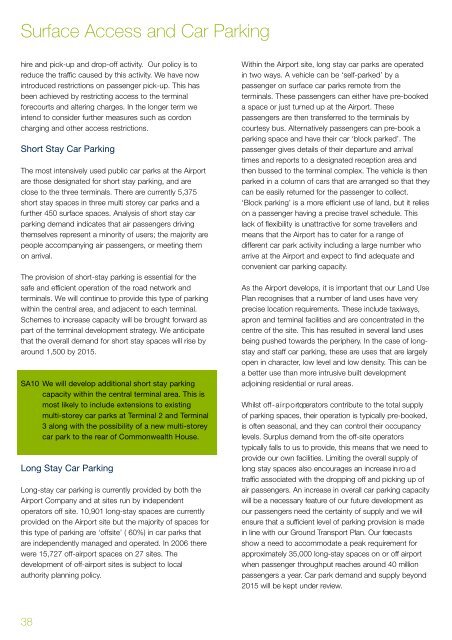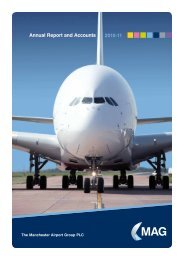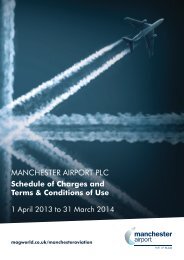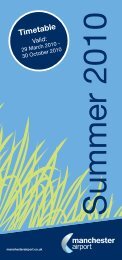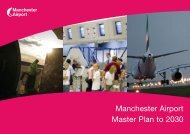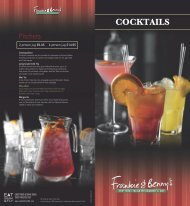Land use plan - Manchester Airport
Land use plan - Manchester Airport
Land use plan - Manchester Airport
Create successful ePaper yourself
Turn your PDF publications into a flip-book with our unique Google optimized e-Paper software.
Surface Access and Car Parking<br />
hire and pick-up and drop-off activity. Our policy is to<br />
reduce the traffic ca<strong>use</strong>d by this activity. We have now<br />
introduced restrictions on passenger pick-up. This has<br />
been achieved by restricting access to the terminal<br />
forecourts and altering charges. In the longer term we<br />
intend to consider further measures such as cordon<br />
charging and other access restrictions.<br />
Short Stay Car Parking<br />
The most intensively <strong>use</strong>d public car parks at the <strong>Airport</strong><br />
are those designated for short stay parking, and are<br />
close to the three terminals. There are currently 5,375<br />
short stay spaces in three multi storey car parks and a<br />
further 450 surface spaces. Analysis of short stay car<br />
parking demand indicates that air passengers driving<br />
themselves represent a minority of <strong>use</strong>rs; the majority are<br />
people accompanying air passengers, or meeting them<br />
on arrival.<br />
The provision of short-stay parking is essential for the<br />
safe and efficient operation of the road network and<br />
terminals. We will continue to provide this type of parking<br />
within the central area, and adjacent to each terminal.<br />
Schemes to increase capacity will be brought forward as<br />
part of the terminal development strategy. We anticipate<br />
that the overall demand for short stay spaces will rise by<br />
around 1,500 by 2015.<br />
SA10 We will develop additional short stay parking<br />
capacity within the central terminal area. This is<br />
most likely to include extensions to existing<br />
multi-storey car parks at Terminal 2 and Terminal<br />
3 along with the possibility of a new multi-storey<br />
car park to the rear of Commonwealth Ho<strong>use</strong>.<br />
Long Stay Car Parking<br />
Long-stay car parking is currently provided by both the<br />
<strong>Airport</strong> Company and at sites run by independent<br />
operators off site. 10,901 long-stay spaces are currently<br />
provided on the <strong>Airport</strong> site but the majority of spaces for<br />
this type of parking are ‘offsite’ ( 60%) in car parks that<br />
are independently managed and operated. In 2006 there<br />
were 15,727 off-airport spaces on 27 sites. The<br />
development of off-airport sites is subject to local<br />
authority <strong>plan</strong>ning policy.<br />
Within the <strong>Airport</strong> site, long stay car parks are operated<br />
in two ways. A vehicle can be ‘self-parked’ by a<br />
passenger on surface car parks remote from the<br />
terminals. These passengers can either have pre-booked<br />
a space or just turned up at the <strong>Airport</strong>. These<br />
passengers are then transferred to the terminals by<br />
courtesy bus. Alternatively passengers can pre-book a<br />
parking space and have their car ‘block parked’. The<br />
passenger gives details of their departure and arrival<br />
times and reports to a designated reception area and<br />
then bussed to the terminal complex. The vehicle is then<br />
parked in a column of cars that are arranged so that they<br />
can be easily returned for the passenger to collect.<br />
‘Block parking’ is a more efficient <strong>use</strong> of land, but it relies<br />
on a passenger having a precise travel schedule. This<br />
lack of flexibility is unattractive for some travellers and<br />
means that the <strong>Airport</strong> has to cater for a range of<br />
different car park activity including a large number who<br />
arrive at the <strong>Airport</strong> and expect to find adequate and<br />
convenient car parking capacity.<br />
As the <strong>Airport</strong> develops, it is important that our <strong>Land</strong> Use<br />
Plan recognises that a number of land <strong>use</strong>s have very<br />
precise location requirements. These include taxiways,<br />
apron and terminal facilities and are concentrated in the<br />
centre of the site. This has resulted in several land <strong>use</strong>s<br />
being pushed towards the periphery. In the case of longstay<br />
and staff car parking, these are <strong>use</strong>s that are largely<br />
open in character, low level and low density. This can be<br />
a better <strong>use</strong> than more intrusive built development<br />
adjoining residential or rural areas.<br />
Whilst off - a i r p o rt operators contribute to the total supply<br />
of parking spaces, their operation is typically pre - b o o k e d ,<br />
is often seasonal, and they can control their occupancy<br />
levels. Surplus demand from the off-site operators<br />
typically falls to us to provide, this means that we need to<br />
p rovide our own facilities. Limiting the overall supply of<br />
long stay spaces also encourages an increase in ro a d<br />
t r a ffic associated with the dropping off and picking up of<br />
air passengers. An increase in overall car parking capacity<br />
will be a necessary feature of our future development as<br />
our passengers need the certainty of supply and we will<br />
e n s u re that a sufficient level of parking provision is made<br />
in line with our Ground Tr a n s p o rt Plan. Our fore c a s t s<br />
show a need to accommodate a peak re q u i rement for<br />
a p p roximately 35,000 long-stay spaces on or off airport<br />
when passenger throughput reaches around 40 million<br />
passengers a year. Car park demand and supply beyond<br />
2015 will be kept under re v i e w.<br />
38


